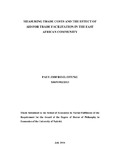| dc.description.abstract | Empirical studies that link measurement of trade costs, aid for trade and trade diversification are rare. Previous research in this area use direct trade cost measurements like transport charges, tariffs, freight rates and composite indexes as proxies for trade cost. It is within this costing framework that this thesis seeks to make an empirical contribution to literature and fill a methodological gap of constructing a single measurement of trade cost, using trade flows, and subsequently empirically determine how aid for trade and trade cost affect trade outcomes. The broad finding is that bilateral trade costs have been declining between East African Community partner countries. While aid for trade invested in economic infrastructure positively affect exports, and trade costs hinder the extent of Kenya‟s export trade diversification. Trade flows are used to measure trade costs. With an objective to construct a theoretically consistent measurement of trade costs that account for intra-domestic trade, the use of trade data includes both direct and unobservable cost factors. Since reductions in trade barriers shift resources between the tradable and non-tradable sectors, they change trade flows. Using bilateral trade data between EAC partner countries, a gravity model is used to measure bilateral costs between the countries. The gravity-based measurement provides a good approximation of bilateral trade costs and shows that EAC partner countries‟ bilateral trade costs have been declining. The empirical verification of the equivalence of tariff costs confirmed that the measurement is explained by traditional gravity variables like distance, borders and membership to Regional Trade Arrangements. The thesis investigates the relationship between aid for trade and export trade within a gravity model. It makes use of data on economic infrastructure, and policy and regulation reforms in Kenya, as reported by the Organization for Economic Corporation and Development Credit
v
Reporting System. The empirical model estimation determines that aid for trade that improves economic infrastructure and the policy environment is a significant determinant of exports in Kenya. Indeed, Aid for Trade invested in economic infrastructure has a positive and significant effect even when aid for policy is not included in the model and when endogeneity is addressed in the estimations. Finally, using export trade data at Harmonised System for 8 digit level for manufactured goods, the thesis calculates the extent of trade diversification in the extensive margin and empirically determines how trade costs affect trade diversification. The measurement confirm that export of manufactured goods from Kenya to the East Africa Community trading partners is less diversified, and is affected negatively by trade costs as measured by the tariff equivalent bilateral costs. The results reported in this thesis should assist policy makers to understand the patterns and determinants of trade costs, what category of aid for trade is significant in prompting exports, and the extent to which trade diversification can be promoted in Kenya. | en_US |



